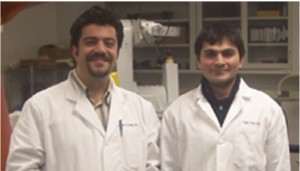Recipients of the University of Pittsburgh Post-Doctoral Research Fellowship

After our arrival in Pittsburgh for a two year research fellowship, we perceived that biomechanics should be more deeply studied in Turkey. With this article (letter), we intend to inform our peers, who wish to get more knowledgeable and do some research on biomechanics.
We have been working at the MSRC (Musculoskeletal Research Center) which is an orthopaedic research laboratory at the University of Pittsburgh since 1990. A variety of projects are going on in collaboration with different departments. The Director is Dr. Savio L-Y. Woo. The center has 3 full time faculty, 7 staff, 12 graduate and undergraduate students (biomechanics), and 11 research fellows (mostly orthopaedic surgeons and residents). The MSRC also collaborates with several labs within and outside the USA. Because of these factors, the MSRC can be called an international lab. Two of the current fellows are from Turkey, while others are from USA, Italy, Germany, Taiwan, China and Japan.
Dr. Woo is a very good researcher on biomechanics and functional tissue engineering, as well as he is a very skilled mentor and teacher. Over 100 young orthopaedic surgeons have been educated at the MSRC. Also, many from our country worked in MSRC. Nowadays in collaboration with Professor MN Doral, a study group is being formed namely WISYR (Woo’s International Society for Young Researchers). With this foundation, the aim is to support and provide both scientific and social communication among the researchers who were educated at the MSRC.
The MSRC has three main study groups: ACL, MCL and Shoulder groups. Each group involves clinicians, biomechanical engineers and computer specialists. Studies are about both the normal and pathological behaviors of musculoskeletal tissues since most of the time we need to know the normal behavior of a tissue to solve the pathological condition. Studies are in a spectrum of microscopic work to joint level work. For example, while the effects of double bundle ACL reconstruction is being studied with robotic tests on cadaveric human knees, one other group works on techniques to enhance tissue and ligament healing. There are 5 distinct labs in the MSRC set-up: Mechanobiology lab, Tissue mechanics lab, Shoulder lab, ACL and Robotics lab and Computational lab. One other characteristic of the MSRC, is that the projects and proposals are carefully scrutinized in a number of meetings on a weekly basis. Proposals are criticized harshly before they become projects and the ones which will not have a contribution to Orthopaedic knowledge are cancelled. The ideas and feedbacks from the meetings help the project to be well established and to be with less technical weaknesses. And as a reward the studies make it to important congresses like the Orthopaedic Research Society (ORS) and International Society of Arthroscopy, Knee Surgery and Orthopaedic Sports Medicine (ISAKOS), and become journal articles in journals like the American Journal of Sports Medicine (AJSM) and Journal of Orthopaedic Research (JOR).
The MSRC has nearly 60 papers published in the last 10 years from the studies done using robotic technology. Most of them are about ACL. Nowadays, the interest is on finding the most suitable fixation angles to create the construct which will provide the most near-normal kinematics to the knee. The Center owns two robots, one of which has been used for over 10 years and the other being a new robot which can apply higher loads. With the universal force moment sensor (UFS) added to the system, the robot can detect the force distribution among the structures of the knee joint with a very low error. It has mainly two modes, one of which is force control and the other is position control. In a standard study, first force control is applied to collect the kinematics of the joint. After that, a position control is done as a replay and the force in the joint is recorded. With this protocol, the forces in the ligaments of the joint can be recorded after making changes on the ligaments (transection, reconstruction). This method gets the forces and kinematics without touching the structures of the knee and this is a huge advantage since it eliminates the effect of contact on forces. And since it can do as many replays as the researcher needs, the same knee can be used to compare the changes made, and this eliminates the individual variation which increases the statistical power.
One of the major interests of the MSRC is biomechanics and tissue engineering of ligaments and tendons or called functional tissue engineering. Use of biological scaffolds and cell seeding are being utilized to enhance soft tissue healing. The final aim is, of course, to perfect the healing after ligament-tendon surgeries and ligament reconstructions. The studies with Small Intestinal Submucosa (SIS) seems promising and the MSRC won the Achilles Award at the last ISAKOS congress in Florida for the current study on this field.
We would like to mention Professor Alp Goksan for his studies on biomechanics in Turkey. However I think it is our duty to move these studies forward. We would like to acknowledge our thanks and appreciation to our Professors who supported and encouraged us to come here for research, and to fellow friends who previously worked in Pittsburgh for giving pointers about the city.
